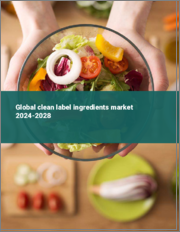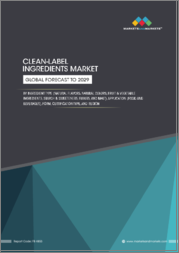
|
시장보고서
상품코드
1628051
세계의 클린 라벨 원료 시장 : 기회, 성장 촉진요인, 산업 동향 분석 및 예측( 2025-2034년)Clean-label Ingredients Market Opportunity, Growth Drivers, Industry Trend Analysis, and Forecast 2025 - 2034 |
||||||
세계 클린 라벨 원료 시장은 2024년 532억 달러에 이르고, 2025년부터 2034년까지 연평균 복합 성장률(CAGR) 6.4%로 성장할 것으로 예측됩니다.
클린 라벨 원료는 천연이며 가공이 최소화되며 인공 첨가물, 착색료, 보존제가 포함되어 있지 않습니다. 이 원료는 투명성과 더 건강한 식품 선택을 요구하는 소비자 수요 증가에 부응하는 것으로 지지를 모으고 있습니다.
시장 확대의 원동력이 되고 있는 것은 소비자의 기호가 투명하고 인지도가 높은 원재료로 시프트하고 있는 것입니다. 건강 의식이 증가함에 따라 사람들은 인공 성분이없는 제품을 적극적으로 요구합니다. 이러한 추세를 통해 음식 및 음료 산업은 클린 라벨 기준에 따라 제품을 개선하고 신뢰를 구축하며 명확하고 정직한 표시에 대한 소비자의 기대에 부응하는 데 주력하고 있습니다.
식물성 식품과 유기농 식품 증가는 시장 성장을 더욱 촉진합니다. 이러한 제품은 건강과 환경의 지속가능성을 우선하는 소비자의 공감을 부릅니다. 식물 기반 식생활이 인기를 끌면서 채식주의자, 유기농 및 최소 가공 식품을 생산하는 제조업체는 진화하는 소비자의 가치에 맞게 클린 라벨 관행을 도입하고 있습니다.
| 시장 범위 | |
|---|---|
| 시작연도 | 2024년 |
| 예측연도 | 2025-2034년 |
| 시작금액 | 532억 달러 |
| 예측 금액 | 993억 달러 |
| CAGR | 6.4% |
제품 유형별로는 전분 및 감미료, 천연 향료, 밀가루, 천연 착색료, 맥아, 과일 및 야채 원료, 기타 등의 카테고리가 있습니다. 이 중 과일 및 야채 원료 부문은 2024년에 129억 달러로 시장을 선도했습니다. 이 카테고리에는 과일 및 채소 유래의 퓌레, 농축물, 추출물이 포함되어 있으며, 영양이 풍부한 제품에 대한 소비자 수요에 대응하고 있습니다. 천연 향료는 또 다른 중요한 분야이며 과일, 허브, 향신료와 같은 소스에서 파생된 진정한 맛 프로파일을 제공합니다.
클린 라벨 원료는 분말상과 액체상이 있어, 2024년 시장 점유율은 분말상이 54.1%로 압도적입니다. 분말은 취급이 용이하고 보존 기간이 길고, 제빵, 과자류, 드라이 믹스, 음료 등의 용도로 범용성이 있기 때문에 선호됩니다. 분말은 정확한 투여가 가능하며, 안정된 결과를 얻기 위해 제조업체에게 매우 선호됩니다.
미국의 클린 라벨 원료 시장은 2024년에 155억 달러에 달했지만, 이는 인공 첨가물과 관련된 위험에 대한 소비자의 의식 증가로 인한 것입니다. 보다 자연스럽고 건강한 대체품에 대한 선호도는 구매 결정에 큰 영향을 미치며 제조업체에게 제품 처방을 준수하도록 촉구합니다. 이러한 추세는 식품, 식품 및 퍼스널케어 업계 전반에 걸쳐 있으며, 클린 라벨 원료가 소비자 수요를 충족시키고 시장 성장을 가속하는데 있어서 매우 중요한 요소임을 뒷받침하고 있습니다.
목차
제1장 조사 방법과 조사 범위
제2장 주요 요약
제3장 업계 인사이트
- 생태계 분석
- 밸류체인에 영향을 주는 요인
- 이익률 분석
- 파괴
- 미래 전망
- 제조업체
- 유통업체
- 공급자의 상황
- 이익률 분석
- 주요 뉴스와 대처
- 규제 상황
- 영향요인
- 성장 촉진요인
- 클린 라벨 제품에 대한 소비자의 기호의 고조
- 음식 및 식품 산업 확대
- 클린 라벨 원료를 필요로 하는 식물성 및 유기 식품의 확대
- 업계의 잠재적 위험 및 과제
- 클린 라벨 원료의 고비용
- 인공 보존료를 사용하지 않고 맛, 식감, 보존 기간을 유지하는 과제
- 성장 촉진요인
- 성장 가능성 분석
- Porter's Five Forces 분석
- PESTEL 분석
제4장 경쟁 구도
- 소개
- 기업 점유율 분석
- 경쟁 포지셔닝 매트릭스
- 전략 전망 매트릭스
제5장 시장 규모와 예측 : 유형별, 2021-2034년
- 주요 동향
- 천연 착색료
- 천연 향료
- 과일 및 야채 원료
- 전분 및 감미료
- 밀가루
- 맥아
- 기타
제6장 시장 규모와 예측 : 형태별, 2021-2034년
- 주요 동향
- 분말
- 액체
제7장 시장 규모와 예측 : 용도별, 2021-2034년
- 주요 동향
- 음료
- 베이커리 및 과자류
- 유제품 및 냉과
- 스낵 및 편의점 식품
- 기타
제8장 시장 규모와 예측 : 지역별, 2021-2034년
- 주요 동향
- 북미
- 미국
- 캐나다
- 유럽
- 영국
- 독일
- 프랑스
- 이탈리아
- 스페인
- 러시아
- 아시아태평양
- 중국
- 인도
- 일본
- 한국
- 호주
- 라틴아메리카
- 브라질
- 멕시코
- 중동 및 아프리카
- 남아프리카
- 사우디아라비아
- 아랍에미리트(UAE)
제9장 기업 프로파일
- Archer Daniel Midland Company
- Brisan Group
- Cargill
- Chr. Hansen A/S
- Corbion
- DSM-Firmenich
- Exberry
- Ingredion
- Kerry Group PLC
- Limagrain Ingredients
- Sensient Technologies
- Tate & Lyle PLC
The Global Clean-Label Ingredients Market reached USD 53.2 billion in 2024 and is projected to grow at a CAGR of 6.4% from 2025 to 2034. Clean-label ingredients are natural, minimally processed, and free from artificial additives, colorants, and preservatives. These ingredients are gaining traction as they cater to the growing consumer demand for transparency and healthier food choices.
The market expansion is driven by a shift in consumer preferences toward transparent and recognizable ingredients. With increasing health awareness, people are actively seeking products that exclude artificial components. This trend is prompting the food and beverage industry to reformulate offerings to align with clean-label standards, focusing on building trust and meeting consumer expectations for clear and honest labeling.
The rise in plant-based and organic foods further fuels market growth. These products resonate with consumers prioritizing health and environmental sustainability. As plant-based diets gain popularity, manufacturers of vegan, organic, and minimally processed foods are incorporating clean-label practices to align with evolving consumer values.
| Market Scope | |
|---|---|
| Start Year | 2024 |
| Forecast Year | 2025-2034 |
| Start Value | $53.2 Billion |
| Forecast Value | $99.3 Billion |
| CAGR | 6.4% |
In terms of product type, the market includes categories such as starch and sweeteners, natural flavors, flours, natural colors, malt, fruit and vegetable ingredients, and others. Among these, the fruit and vegetable ingredients segment led the market in 2024, valued at USD 12.9 billion. This category encompasses purees, concentrates, and extracts derived from fruits and vegetables, addressing consumer demand for nutrient-rich products. Natural flavors are another significant segment, providing authentic taste profiles derived from sources like fruits, herbs, and spices.
Clean-label ingredients are available in powdered and liquid forms, with the powdered segment holding a dominant market share of 54.1% in 2024. Powders are favored for their ease of handling, extended shelf life, and versatility in applications such as baking, confectionery, dry mixes, and beverages. They enable precise dosing and are highly preferred by manufacturers for consistent results.
U.S. clean-label ingredients market reached USD 15.5 billion in 2024, driven by growing consumer awareness of the risks associated with artificial additives. The preference for natural, healthier alternatives has significantly influenced purchasing decisions, prompting manufacturers to adapt their product formulations. This trend spans across the food, beverage, and personal care industries, solidifying clean-label ingredients as a crucial factor in meeting consumer demand and driving market growth.
Table of Contents
Chapter 1 Methodology & Scope
- 1.1 Market scope & definition
- 1.2 Base estimates & calculations
- 1.3 Forecast calculation
- 1.4 Data sources
- 1.4.1 Primary
- 1.4.2 Secondary
- 1.4.2.1 Paid sources
- 1.4.2.2 Public sources
Chapter 2 Executive Summary
- 2.1 Industry synopsis, 2021-2034
Chapter 3 Industry Insights
- 3.1 Industry ecosystem analysis
- 3.1.1 Factor affecting the value chain
- 3.1.2 Profit margin analysis
- 3.1.3 Disruptions
- 3.1.4 Future outlook
- 3.1.5 Manufacturers
- 3.1.6 Distributors
- 3.2 Supplier landscape
- 3.3 Profit margin analysis
- 3.4 Key news & initiatives
- 3.5 Regulatory landscape
- 3.6 Impact forces
- 3.6.1 Growth drivers
- 3.6.1.1 The rising consumer preference for clean-label products
- 3.6.1.2 Expanding food & beverage industry
- 3.6.1.3 Expansion of plant-based and organic food products requiring clean-label ingredients
- 3.6.2 Industry pitfalls & challenges
- 3.6.2.1 High cost of clean label ingredients
- 3.6.2.2 Challenges in maintaining taste, texture, and shelf life without artificial preservatives
- 3.6.1 Growth drivers
- 3.7 Growth potential analysis
- 3.8 Porter's analysis
- 3.9 PESTEL analysis
Chapter 4 Competitive Landscape, 2024
- 4.1 Introduction
- 4.2 Company market share analysis
- 4.3 Competitive positioning matrix
- 4.4 Strategic outlook matrix
Chapter 5 Market Size and Forecast, By Type, 2021-2034 (USD Billion, Kilo Tons)
- 5.1 Key trends
- 5.2 Natural colors
- 5.3 Natural flavors
- 5.4 Fruit and vegetable ingredients
- 5.5 Starch and sweeteners
- 5.6 Flours
- 5.7 Malt
- 5.8 Others
Chapter 6 Market Size and Forecast, By Form, 2021-2034 (USD Billion, Kilo Tons)
- 6.1 Key trends
- 6.2 Powder
- 6.3 Liquid
Chapter 7 Market Size and Forecast, By Application, 2021-2034 (USD Billion, Kilo Tons)
- 7.1 Key trends
- 7.2 Beverages
- 7.3 Bakery & confectionery
- 7.4 Dairy & frozen desserts
- 7.5 Snacks & convenience foods
- 7.6 Others
Chapter 8 Market Size and Forecast, By Region, 2021-2034 (USD Billion, Kilo Tons)
- 8.1 Key trends
- 8.2 North America
- 8.2.1 U.S.
- 8.2.2 Canada
- 8.3 Europe
- 8.3.1 UK
- 8.3.2 Germany
- 8.3.3 France
- 8.3.4 Italy
- 8.3.5 Spain
- 8.3.6 Russia
- 8.4 Asia Pacific
- 8.4.1 China
- 8.4.2 India
- 8.4.3 Japan
- 8.4.4 South Korea
- 8.4.5 Australia
- 8.5 Latin America
- 8.5.1 Brazil
- 8.5.2 Mexico
- 8.6 MEA
- 8.6.1 South Africa
- 8.6.2 Saudi Arabia
- 8.6.3 UAE
Chapter 9 Company Profiles
- 9.1 Archer Daniel Midland Company
- 9.2 Brisan Group
- 9.3 Cargill
- 9.4 Chr. Hansen A/S
- 9.5 Corbion
- 9.6 DSM-Firmenich
- 9.7 Exberry
- 9.8 Ingredion
- 9.9 Kerry Group PLC
- 9.10 Limagrain Ingredients
- 9.11 Sensient Technologies
- 9.12 Tate & Lyle PLC



















